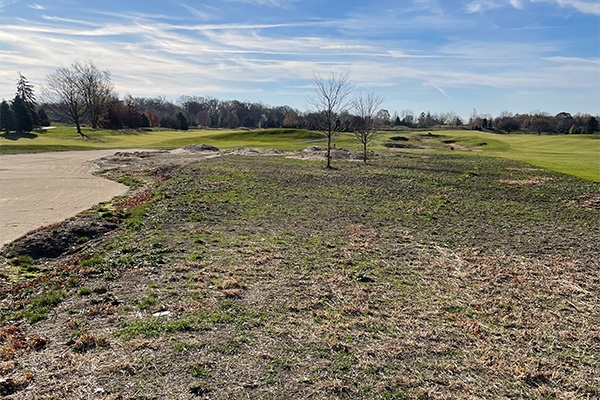On December 21, 2022, it was announced that a restorative Purdue University research project is seeking to make golf courses ecologically friendly for pollinator species.
With their expanse of acreage — well over 100 acres on average ― golf courses provide untapped potential to benefit wildlife via ecological restoration.
That is why the National Wild Turkey Federation (NWTF) is partnering with the U.S. Golf Association, the U.S. Fish and Wildlife Service, Pheasants Forever and other partners to facilitate new research being conducted by Purdue University’s Turf Science and Entomology departments.
“There is increasing interest in converting golf course out-of-play areas from turfgrass to naturalized areas dominated by native prairie vegetation,” said Doug Richmond, Purdue University professor of turfgrass entomology and soil insect ecology.
“Golf courses undertaking such a project require science-based information that provides a clear picture of likely outcomes to help guide their efforts. Unfortunately, this information is presently lacking, especially for those hoping to chart a course for achieving success on an abbreviated renovation timeline that is acceptable to golf course staff and clientele,” he explained.
When the opportunity presented itself to be a part of this unique project, the NWTF Indiana State Chapter voted unanimously to provide support and fund the pollinator seed mix for roughly 7 acres of planting.
“We are proud to be a part of this endeavor,” said Pat McFadden, NWTF Indiana State Chapter habitat coordinator.
“This is an opportunity to promote not just the NWTF and our mission, but the importance of native pollinator species. What is now an ongoing research project has the potential to be a country-wide initiative to increase biodiversity on thousands of acres,” she continued.
Richmond and an accompanying M.S. student will seek to create a roadmap of how to complete such a conversion effectively, cost efficiently and in a way that contributes to enhancing biodiversity. But what does this have to do with wild turkeys?
Pollinators are often the unsung heroes of thriving wildlife habitats. Bumblebees, honeybees, butterflies, moths and countless others contribute to the ecosystem and agricultural operations in countless ways that cannot be overstated.
Studies have consistently shown a direct relationship between plant diversity and pollinator diversity; the more robust and diverse plant communities are, the more diversified insect and pollinator communities will be.
The general health of an ecosystem can be attributed to its pollinator population’s health. Simply put, if pollinators are thriving, it is more than likely that wild turkeys and numerous other species are equally thriving. This, coupled with the increasing decline of pollinator habitat throughout the U.S., is why the NWTF takes creating and enhancing pollinator habitat seriously.
“Pollinators and other insects are a critically important food source for rapidly-developing poults as well as nesting females,” said Ryan Boyer, NWTF district biologist for Michigan, Ohio and Indiana.
“This research project focuses on the process of restoring native prairie pollinator habitat on golf courses to transition these large areas with little wildlife value into diverse areas benefiting a suite of species inclusive of our beloved wild turkey. This research project aims to outline a cost-effective formula that assists golf course managers interested in transitioning low-value areas requiring intensive management into pollinator habitat periodically managed through prescribed fire or mowing. The impact this could have 10 years down the line, if replicated throughout the country, is no doubt a conservation win for people and wildlife,” he added.
The testing ground for the emerging research is the Kampen Golf Course in West Lafayette, Indiana. Designed by renowned golf course designer Pete Dye, the course is an 18-hole, links-style, par-72 championship golf course. The course touts a challenging layout for golfers of all abilities with its vast sand bunkers, ponds, a natural celery bog and, soon, many areas with native pollinator plant species.
“We’re renovating several areas on the Kampen course that were previously fescue or ‘waste’ areas,” Richmond said. “Specifically, a waste bunker along hole number 8; a fescue area lying between number 6, 7 and 8; a fescue area along number 3; and a waste area between 3, 4 and 16, about 6.5 acres in all.”
Richmond, along with the M.S. researcher and the staff at the Kampen Golf Course, will evaluate the effects of seeding time, method of plantings, establishment success and pollinator diversity, and will measure success by characterizing and quantifying changes in the plant and pollinator community over the two and a half years of the project.
A secondary aspect of the research is gauging the attitudes and impressions of those using the golf course. The team at Purdue plans to make this information available for anyone seeking to convert cool-season grasses into native pollinator habitat.
“The NWTF works to restore native habitats like the native prairie soon to be established on the Kampen Golf Course across much of the country on public and private lands; however, this unique partnership can help be the catalyst for us and our partners to showcase the importance of these habitats to largely a new demographic of outdoor recreationists and replicate on these courses across the country,” Boyer said.
Since 1973, the National Wild Turkey Federation has invested over half a billion dollars into wildlife conservation and has conserved or restored over 22 million acres of critical wildlife habitat. The organization continues to drive wildlife conservation, forest resiliency and robust recreational opportunities throughout the U.S. by working across boundaries on a landscape scale.
Photo courtesy of Purdue University.

